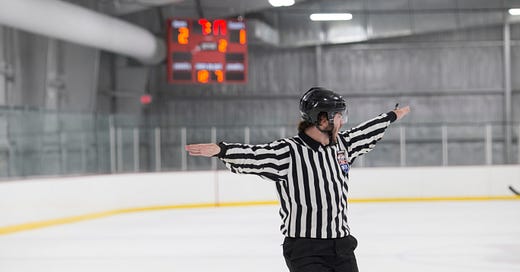In today’s post, we dive into hockey history to learn about icing, how it originated, and how the rules came to be today. We’ll also touch on some potential future changes that we think could make our sport even better.
Speaking of history, our friend Jack Han is releasing an e-book where he dives into historical hockey tactics. It’s called “Hockey Tactics Retrospective” and we heartily endorse it.
A Brief Word On Icing
Icing the puck on the penalty kill is very common. If you head to a rink you’ll hear parents, coaches, and players alike yelling “ice it!” Yet, did you ever step back and ask yourself, why do we allow a team to ice the puck when shorthanded?
I’m a history nerd and the stories of history really help my thinking and memory. As a little side research project, my referee friend Blair Bigwood helped me track some history regarding icing the puck and rule changes around it.
Many teams adopted the strategy of icing the puck when they were in the need of a line change due to tired players. Therefore they would deliberately ice the puck to stop play and get their line change. Starting in the 2005–06 NHL season, teams were not allowed to change before the next faceoff. Many other leagues have since followed suit.
Types of icing
No-touch (automatic) icing - Once the puck is shot beyond the goal line, the whistle is blown for icing
Touch icing - Players race to touch the puck. If the defenders touched the puck first, it‘s deemed icing.
Hybrid icing - Players race to the puck and the first to the dots (imaginary line across the ice connecting through the faceoff dots) determines whether icing is called (if the defending team wins the race) or not (if the offensive team wins the race or it’s too close to call).
Most hockey leagues worldwide now use hybrid icing.
NHL began using hybrid-icing rules in the 2013–14 season, after several decades of using touch icing.
IIHF switched to hybrid icing in 2014. They previously had used automatic icing The reason they had automatic icing was due to a tragic incident in 1990 surrounding Luděk Čajka. He crashed into the boards after chasing down an icing, suffered severe spinal injuries, and died a few weeks later.
1937 Icing Rule
The NHL first introduced “icing” in 1937 to eliminate a common delay tactic used by teams protecting a lead (E.g. Dumping the puck all the way down the ice in order to protect a lead. Legend has it some teams would do this 50 times to protect a lead).
This was only applied in even-strength hockey. Icing was still allowable during the penalty kill. At this time, the power play would last two minutes regardless if a goal was scored.
The rule was amended in 1951 to state the icing infraction was nullified if the goaltender touched the puck.
1955-56 Montreal Canadiens
Like most things that spur change, an outlier caused it. Tiger Woods did it in golf and spurred “tiger-proofing” of many courses.
During the 1955-56 NHL season, the Montreal Canadiens’ Hall-of-Fame loaded team had a powerful power play so lethal that it was commonplace for them to score multiple goals on the same power play.
At the NHL’s annual meeting in June 1956, the NHL governors voted in the new rule releasing the penalized player if a team scored on the power play.
26(c) If while a Team is "short-handed" by one or more minor or bench minor penalties, the opposing Team scores a goal, the first of such penalties shall automatically terminate.
WHA
The 1970s-era World Hockey Association (WHA) was a rival league to the NHL. They even had a winning record against NHL teams in interleague exhibition games. They had many innovative ideas and were known to try and create more entertainment. For example, they:
Instituted a 10-minute sudden-death overtime to break ties (Note: The NHL followed suit in 1983-84 with a 5-minute sudden-death OT).
Tried using blue-colored pucks in hopes that fans could see them easier to see.
Didn’t allow shorthanded teams to ice the puck.
This is the first time we found that a team was unable to ice the puck when short-handed.
2017 USA Hockey Rule Change
Starting for the 2017-18 season, USA Hockey adopted a rule change that eliminated the shorthanded icing exception. They adopted the rule after testing it out in key locations in the USA and saw success with it. This rule change only impacts 14U and younger age groups.
The rationale behind this rule change is that it encourages greater skill development for players in their prime skill development windows. Players are now forced to use puck possession, puck protection, and play-making rather than the low-skill icing tactic.
This wasn’t the first time a hockey league had the rule in place. The USHL experimented with no icing on the penalty kill in 2015 to great success.
Future Ideas
USA Hockey regularly holds regional camps to identify/evaluate talent. In the western region, they have experimented with moving the icing line from the red line to the attacking blue line.
As you would expect, the first day was difficult as players adapted, but during day 2 and beyond there were some interesting consequences, some intended, others unintended.
Intended consequence = greater problem solving and thoughtfulness.
Unintended consequence = defenders had better gaps and placed a greater priority on defending the blueline.
As people who love to see players express their skill and problem solve, we love this line of thinking and want to see more games played without icing on the PK and the icing line moved to the attacking blue line.
Further Reading - How Marty St Louis uses his elite hockey mind to coach youth hockey (hint, encourage, and create environments ripe for problem-solving)
Did you enjoy this newsletter?
Help us spread the ideas within and share it with the people you care about



